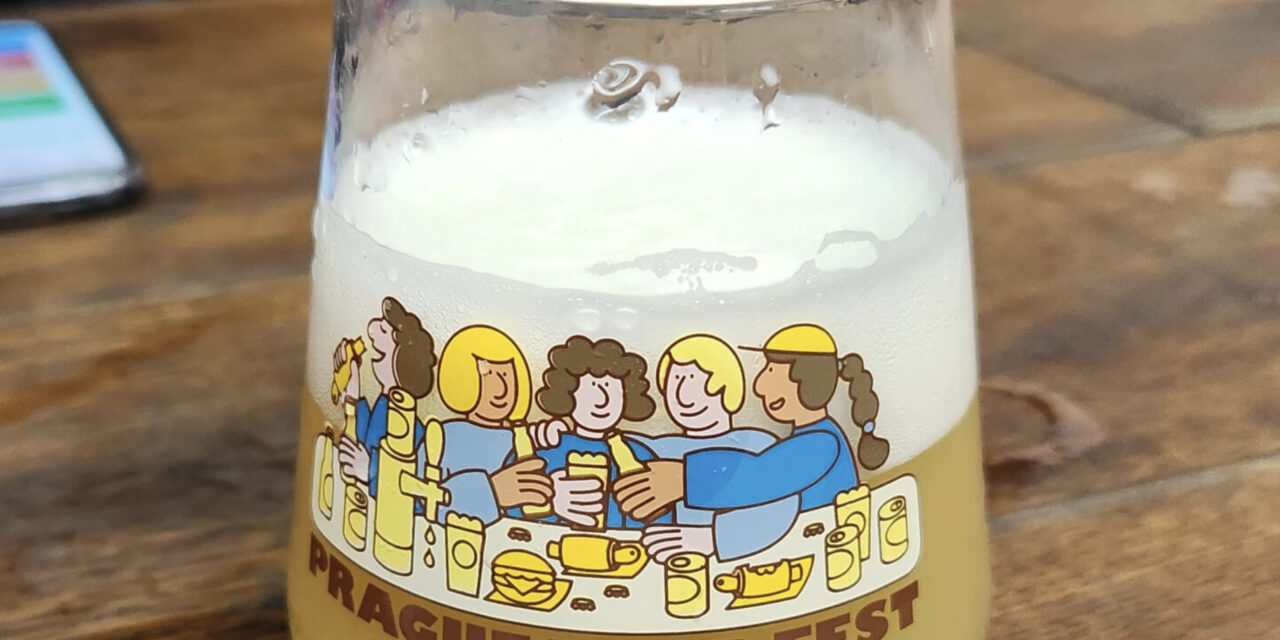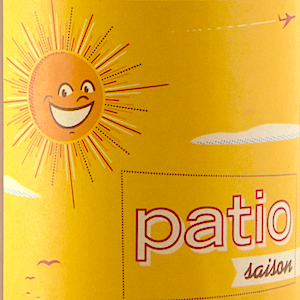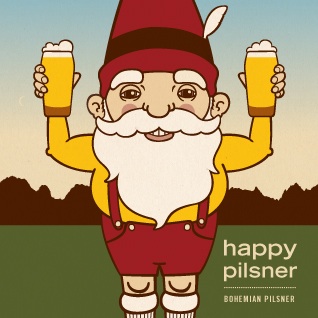“…Citizens, this invention is capable of establishing mutual understanding not only between towns, but also between nations, we welcome wireless telegraphy as the helpmate of the whole of humanity! For understanding among the people of all continents, all races, all nations!’ Mr Zalaba declaimed, brandishing his arm in the air…” -Bohumil Hrabal, Cutting It Short
Jacob really wants me to believe in the mug of New England IPA that he has placed in front of me.
I like Jacob. With his partner, Martin, he runs Prague Craft Beer Tours. I’ve worked as a tour guide, and it’s a sure sign that he’s good at his job that he cares about my experience. I’ve just checked in at the hotel and have managed a quick half of Red IPA from Pivovar Clock by the time I run into him. He’s got me for a limited amount of time before dinner; just a couple of hours. That means he has to cut down the usual experience and choose something exceptional.
A four or five stop jaunt on the tram and we’re at Pult.
Pult is a marvel. With its gothic vaulted ceiling, the beer hall stretches back from the street, and while it’s airier than most of the beer halls in Praha 1, you almost never find yourself looking up. On one side, a set of wooden benches and tables filled with families, couples, and the odd pub loiterer. On the other, a polished draught tower of aeronautical chrome sleekness mounts a twenty foot length of stainless steel counter. The backlit yellow tap list creates a subtle glow in the room, advertising six lagers and three craft beer styles.
Czechia has German loan words, but since many people speak fluent English, I’m not sure whether it’s Pult because they’re pulling pints or because of the connotation of a lectern or pulpit. Either way, the elaborate ritual behind the bar draws the eye. Jacob explains that the tapster, Madga, was a brewer who decided that the service of beer was more important than its creation. She washes each thick walled mug with a special detergent and an outsized sponge, rinsing it thoroughly before depositing it in an orderly temperature controlled basin that sits around five degrees celsius.
She is in constant motion attending to some detail and for that reason, she pulls the focus of the room. Not only will the glass be beer clean, but it will hold the temperature of the beer that goes into it. When the time comes to fill the glass, the side pull tap runs at a trickle briefly before she positions the glass under it with a practised roll of the wrist, allowing foam to build before it is opened fully. The tap, inserted in the glass below the level of the foam, pours freely and the beer never touches oxygen. The creamy foam sits atop the glass like fresh snowfall, pristine.
I take an appraising sniff and a sip under Jacob’s watchful eye. Darren, who’s come with us from the hotel, points out that it’s very buttery, and there is certainly more than the average amount of diacetyl. I’m focusing mostly on the unfamiliar smoothness of a New England IPA on a side pull tap, degrees silkier than its Vermont forebears. Looking at Darren, there’s a mutual nod of appreciation that this is a different creature than we’re used to, and that seems to satisfy our host.
A fruited sour from Dva Kohouti down the road in Karlin follows, Místní Kyseláč 11°, which really just raises more questions. How is anything sitting at 4.2% this rich and unctuous? Where fruit will sometimes add a touch of velvet texture this seems extreme, although it’s hard to argue with the smoothness and the integration of flavours. Hendrych’s H11 is much more what I expected, unpasteurized, unfiltered, and with a brawling 48 bitterness units. By the time we get to the familiar territory of Budvar, I’m thoroughly confused, but having a wonderful time.
————————————
Beer expertise doesn’t always translate well between markets.
You might know how things work where you’re from, but you grew up in a context defined by decades of other people’s decisions, and what you’re exposed to defines your taste. By the time I was old enough to pay attention to beer, around 1996, Canada was down to two nationally sized beer companies, one of which was proudly telling people, “I Am Canadian,” while the other was sheepish about the fact that they were now Belgian. Aside from consolidation after prohibition, Canada’s beer market never really faced much in the way of serious disruption in the 20th century.
Czechia, on the other hand, emerged from the first World War as The First Czechoslovak Republic, which lasted for about twenty years. Much of the next fifty years saw German or Russian control of the state until the Velvet Revolution in 1989. The current attitude towards independence is clearly visible in the Old Town Square where the Czechian and Ukrainian flags hang side by side.
During this period, breweries tended to be nationalised as part of a Communist centrally planned command economy, and the number of beer styles on offer was reduced to two: Světlý and Tmavý. In some ways, this was preservative of the industry. In large enough towns, the people had banded together in the 19th century to fund the construction of their own municipal breweries for their communal enjoyment. Whether that was in Plzeň, České Budějovice, Benešov, Nymburk, or elsewhere, these nationalised businesses were not modernised in the way that breweries in North America were. Earlier brewing tradition and technique spanned into the modern era.
As a result, Czechia has a national palate. Because the breweries had the ability to produce their own malt, decoction is a standard part of the brewing process, resulting in caramelization and a honeyed depth of Pilsner malt flavour. Because of primary fermentation in open vats, diacetyl is not only standard, but structurally integral to the palate of the beer. If it were merely bitter, there would be no journey. Because of the long lagering time there’s an integration of aroma and flavour that favours drinkability.
Evan Rail is explaining the national palate for us at the Břevnov Monastery Brewery. Their Světlý Ležák is quite heavy on the diacetyl, with the slick texture that is its hallmark, well above what would be common in North America and actually higher than you might find in a training spike. In their darker lager, the Tmavý, this results in a marvellous vinous fruitiness, practically blackcurrant, in the mid palate that never quite descends to roast grain before being redeemed by a gentle drying bitterness .
In the wake of the Russian takeover of the region, Religion was highly constrained. In 1950, the monastery was expropriated by the Communist state secret police and the Abbot, Jan Anastáz Opasek, was condemned in a show trial as an agent of the Vatican. The sentence saw him spend a decade in various prisons before an amnesty was declared in 1960. Although he spent time in Austria and Bavaria, he returned as Abbot after negotiating the return of the monastery to his order in the wake of the Velvet Revolution and served for the rest of his life until 1999 as Archiopath.
The brewery has been active on and off since 993 AD, founded by St. Adalbert. The brewery reopened in the monastery’s stables in 2011 after an absence of 120 years using traditional methods including open fermentation vats. It’s part of the Catholic tradition of Klosterschenke or monastic brewing and although Evan is quick to point out that Czechia is statistically one of the most atheistic nations on the planet, I’m left with a twinge of doubt.
In a country where every small town has a church and a tavern, shutting down one forces people to congregate in the other, and it seems to me that the tavern became a surrogate for the church.
——————————————————-
In the wake of the Velvet Revolution, the ownership of Czechia’s breweries was returned to the people. In some cases, such as Pilsner Urquell and Staropramen, ownership has transferred outside of the country as the shares consolidated. It’s the nature of international merger and acquisition that larger companies like Asahi and Molson Coors should make such purchases.
Imagine if one of your nation’s largest breweries had a decision making process that was not bound up in quarterly shareholder reports. Imagine if instead of profit margin and market penetration, it simply focused on making a product of incredible quality that everyone would enjoy.
That is Budvar. It is a state owned brewery. Budvar is the apotheosis of a beer loving people’s will. If the trend in the 19th century was for communally owned municipal breweries, then Budvar makes complete sense. Compared to other Czech breweries with the same pedigree, Budvar is decidedly more modern, having undergone a significant expansion in 2018. Although it is state owned, the brewery had to pay for its own expansion and the dividend to the Czech people was, very simply, additional beer.
The brewmaster, Adam Brož, cheerfully leads us through the facility, a mixture of old and new construction. The brewing deck, with its massive decoction setup and kettles, is older. The floor to ceiling windows flood the room with light, which changes the feel from humid to tropical, and palm fronds thrive in the space. The tile in the room is pristine. The brewers wear white togs head to toe, practically scrubs, because anything else would be impractical in the space. Their tiny desk fans cannot possibly make a difference.
Budvar is made with Moravian malt. The Saaz hops, which come in burlap wrapped bales, are broken up for addition to the kettle with a small blackened hatchet, the resin having oxidised on the blade over an untold number of batches. While the quantity of hops looks significant, Budvar is more gently hopped than many examples of Světlý Ležák. Budvar 33, made with the newer Agnus hop, is slightly more bitter and a touch more floral, but still exquisitely balanced.
Budvar’s yeast character is obfuscated somewhat by the long conditioning of the beer; it spends an unheard of 90 days lagering. The brewery in Nymburk uses the same strain and at 45 days, there’s a faint hint of bubblegum and banana, but there’s no diacetyl to speak of in the aroma or on the palate. The expansion in 2018 has increased the size of the fermenters tenfold, taking the brewery over two million hectolitres a year, and drastically increasing efficiency.
Typically expansion comes with the competitive instinct to put others out of business, but in the brief period of eight days, everyone I talk to at competing breweries has only positive things to say about Budvar. Milan Rejholec of the small but mighty Andělský Pivovar is quick to tell me that during the pandemic, Budvar reached out to ask if there was any way they could help with packaging the product. Budvar is not merely in the beer business. They are in the business of Czech Beer and they’re supporting the sector.
During the summer in North America, you might be lucky to see two weeks of lagering from most breweries as they attempt to capitalise on the increased seasonal volume. You could make a beer with cheaper malt. You could make a beer with pelletized hops. If you were trying to maximise volume, you could turn those fermenters four or five times in 90 days. Not here. This is the brewery of the Czech people, and the mission statement is painted on the wall of the cellar.
Dej Bůh štěstí. May God Give You Happiness.
—————————-
Bohumil Hrabal, whose likeness adorns the wall of U Zlatého Tygra in the old town of Prague, is one of the country’s most cherished novelists. His works were largely distributed in Samizdat editions between 1968 and 1974, retyped or copied by hand. His narrators are given to a stream of consciousness style, palavering in drawn out monologues as you might when three pints deep. His book Postriziny or Cutting it Short managed to find publication in 1975, potentially because it didn’t deal with politics directly. It dealt in something far more damaging: nostalgia.
Set in a brewery and narrated by the wife of the brewery manager, the text juxtaposes the pastoral life of a small town and the characters that make up its population with the overwhelming power of modernity. The introduction of the radio is the harbinger of a kind of mania for fashion, resulting in exposure to new music and new ideas that transform the life of the town’s inhabitants. The narrator, who can sink a litre of beer in a single go, selects a Josephine Baker haircut and the men of the town are heartbroken. While it might not sound like high drama, the tension between ways of life is illustrative of the mood of the author’s time.
Drinking a Cold IPA, a style that really only caught on through instagram, I’m looking around at the brewers in their individual tents at the Prague Craft Beer Festival. I don’t think any of them can be much older than forty, and I’d put most of them in their late twenties. That means that most of them were born after the Velvet Revolution. Most of them are on social media, and I’ve seen what that has done to breweries grasping after trends, divesting meaning from their offerings as they switch out hops week after week. For a minute, I’m very worried.
In Canada, a lot of my friends chose craft beer initially because it seemed like a revolt against big brewery products. Molson and Labatt generally made products that were sold based on their advertising and not their quality. Brewers will politely say that those beers are very technically proficient, but through clenched teeth.
In Czechia, there’s not a lot to revolt against. The big brewers make some of the best beer in the world. It’s affordable and it’s well kept. The country has brewing schools at the secondary and post-secondary levels. Brewing, right down to the ingredients, is inculcated in the country’s life. Craft Beer seems less like revolt and more like reclamation.
How do you reconcile the history of your country and the meaning its brewing industry has had to its identity when instagram is telling you that everyone else is making tropical fruit scented hazy beers that lie outside your wheelhouse? How do you innovate when a beer created within your borders influenced ninety percent of the beer available on the planet?
Joyfully, it turns out. If there’s cultural memory, it’s being applied in the country’s craft breweries. Since you can only work from a familiar context, that means that some of the beers are slightly higher in diacetyl than you might expect. It means that some of the hopping results in properly bitter beer with a drying finish. It means that some IPA styles are conditioned for a good deal longer than you’d find in other countries, smoothing them out.
Czech Craft Beer has an accent. The Kaja 12 from Chroust Brewing Co is a double dry hopped Světlý Ležák with Simco Cryo, Citra, and Motueka hops, and it’s brilliant. It couldn’t be from somewhere else if it tried.
—————————-
If there’s one thing the world can take away from Czech beer culture, it’s the profound seriousness with which they treat beer. Whether it’s the locally grown and processed malt and hops, the lengthy brewing process that results in exceptional drinkability, or the focus of the tapsters who keep the beer in excellent form at the tavern, the attention paid to detail is reverential.
The attitude seems to be that the beer should be good enough that it is simply not worth remarking upon. It should not be rare or exclusive, there should not be lineups unless the tavern is exceptionally busy. The tavern should be the backdrop and the beer a prop as you meet with your friends and neighbours and get on with setting the world to rights. The congregation is the most important factor, and the beer should be so good that it warrants an appreciative nod before you get on with the day’s conversation. It should be so good that you are not tired of it four pints in, that you don’t notice the evening slipping away in genial company and comfort.
Beer should be about people, because what else is there?
The only way to achieve that is to take it incredibly seriously, and no one else will handle the details for you. If God is in the details, then dej Bůh štěstí.
Part One of this article can be found right here.






































